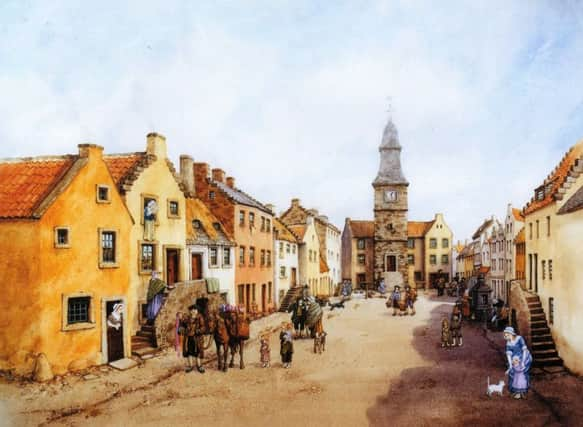Landmark that towers above heritage works


For me, pride of place must go to the steeple which looks as good as it did back in 1814. This Townscape Heritage Initiative (THI) is the second major refurbishment project this decade following the fantastic work in the old graveyard around the Parish Church (now Falkirk Trinity) and there is an interesting link between the two.
During the churchyard project, workmen uncovered a few old gravestones which had survived the great cull of 1962.
Advertisement
Hide AdAdvertisement
Hide AdBack then, the graveyard had been cleared and many fine stones were consigned to the dustbin of history . . . actually they were smashed up and used as bottoming for the road into the crematorium! Most of the new discoveries were in poor condition but one was near perfect, a sandstone and marble stone which declared: ‘‘The burial ground of William Glen of Forganhall JP who died 24 August 1808 aged 64’’.
The same William Glen who ‘‘dinged doon the steeple’’ in 1803 and so upset the Falkirk ‘‘bairns’’ that his name has forever been associated with this vile deed.
William seems to have made his money in West Plean as a distiller before he purchased an estate in Dalderse which he called Forganhall, a name with family connections.
He set about being a good citizen serving as a road jrustee and a Justice of the Peace.
Advertisement
Hide AdAdvertisement
Hide AdDuring the Napoleonic Wars he offered a guinea (over a pound) to any man from Stirlingshire willing to enlist in the navy to fight for the King. This was no small amount back then and suggests that William was doing well financially.
In the early 1800s he turned his attention to the 1697 town steeple which was attached to a little tolbooth building.
Both it, and the tolbooth which held the jail cells in the basement, were in poor condition with the steeple leaning slightly to the east.
Glen decided to purchase the tollbooth part from William Forbes of Callendar and replace it with new shops.
Advertisement
Hide AdAdvertisement
Hide AdIn the written agreement with Forbes he was forbidden to dig around the foundations or do anything that would threaten the steeple but, of course, he did just that.
As a result of the illegal excavations the lean became more pronounced and there was now a large crack in the stonework.
The authorities decided to have it ‘‘cast to the ground’’ to save the ‘‘bairns’’ from disaster!
The owners of the steeple, the famously penniless Stentmasters, demanded compensation and after years of legal claims and counter-claims Glen was found liable in 1811 and made to pay £450 towards the cost of a new steeple.
Advertisement
Hide AdAdvertisement
Hide AdI don’t suppose he was particularly worried because, as the gravestone tells us, he had died three years earlier leaving his heirs to find the cash.
The Stentmasters then raised the new steeple which still graces our town centre.
Pete Reid of the council’s economic development services team along with Julia Ng, the THI project officer, and all their colleagues, deserve high praise for masterminding the tricky THI over the last five years thereby playing a part in giving our town centre the boost it needs in the battle to bring people back into the town to live, work, shop and eat.
Let us also remember William Glen of Forganhall whose ‘‘lost’’ gravestone was re-erected in the churchyard.
Without his carelessness we might not have the crowning glory of the High Street, the good old Fa’kirk Steeple!